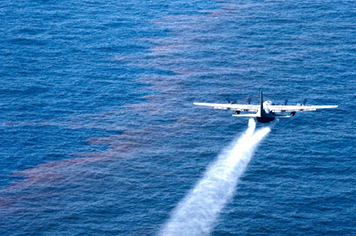Dispersants: A Guided Tour
People responding to an oil spill may use several kinds of "countermeasures" intended to reduce the harm caused by the spill. Dispersants are one kind of countermeasure. Take this guided tour to get a basic explanation of what they are and how they work.

1. What Are Dispersants?
Once oil has spilled, people use oil spill countermeasures to try to reduce the adverse effects of spilled oil on the environment.
Dispersants are one kind of countermeasure. They are chemicals that are applied directly to the spilled oil in order to remove it from the water surface, where oil can be especially harmful.
More Information about Dispersants
Dispersant Application Observer Job Aid: This field guide is helpful for people who are observing the application of chemical dispersants to oil spilled on the water.
Watch a Dispersant Application: This U.S. Coast Guard video shows the application of dispersant by aircraft after an estimated 18,000 gallons of fuel oil were spilled from the tank ship Krymsk off of Galveston, Texas on Oct. 20, 2009.
SMART: SMART is a monitoring program for dispersant application and in situ burning.
